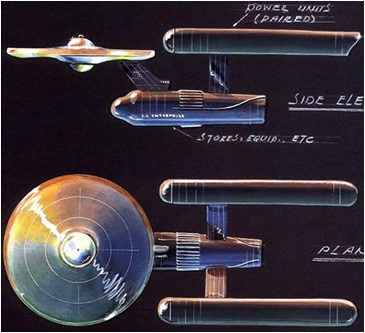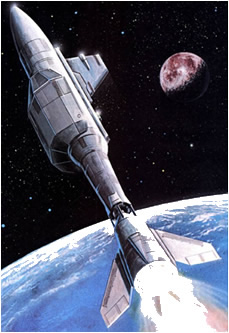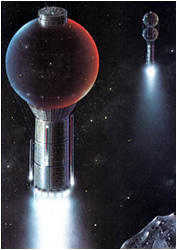|
In 1964, everything that would become Star Trek as it is
known today rested in the handful of typewritten pages that had convinced
Desilu studios to enter into a three-year television development deal with
Gene Roddenberry. Those pages described the mission of the U.S.S. Yorktown,
a spaceship with a crew of 203 commanded by Robert T. April. Landing parties
would be beamed down to planets by an energy-matter scrambler, stay in
contact with the Yorktown on their telecommunicators, and protect
themselves
with Laser Beam weapons.
Though the terminology was still to be refined, the
cornerstone of a billion-dollar entertainment franchise was solidly in
place. And when NBC committed to ordering a pilot episode in June 1964, it
was time to start building that franchise's foundation. As Star Trek
producer Gene Coon said, "Gene created a totally new universe." Television
being a visual medium, the question now was, what was this universe going to
like like?
Today, Star Trek senior illustrator and technical consultant
Rick Sternbach refers to the three filters that stand between any Star Trek
designer and the blank page. First, and most important from the business
side of the filmed entertainment industry, is the filter of Money. How much
will a design cost to be translated into physical reality - or at least the
illusion of physical reality - on screen?
Second is the filter of Practicality. Does a design look as
if it can do what it is intended to do? Many artistic judgments come into
play here. Does a weapon look theatening enough for the audience to realize
it is a weapon? Is an alien machine too alien to understand, or too easy to
identify and thus not alien enough?
The third filter is the one to which the audience most
strongly reacts; History. This is the filter of all that has gone before in
Star Trek. It is the visual continuity, sometimes strong, sometimes almost
subliminal, which links the original television designs to those of the
later movies and series. Though hundreds of artists have contributed to the
refinement and evolution of this last filter over the past three decades, in
the beginning there were two who wrote the first pages of that history: the
art director assigned to the first Star Trek pilot, Pato Guzman, and his
assistant, Walter Matthew Jefferies. Guzman left Desilu before the pilot
began filming in October. Initially, he was replaced by Franz Bachelin, and
then by Matt Jefferies, who became art director for the series.

As art director, he was given the assignment to design the
Enterprise itself. His only guidelines were Roddenberry's firm list of what
he did not want to see: not any rockets, nor jets, nor firestreams.
The starship was not to look like a classic, and thus dated, science-fiction
rocketship, but neither could it resemble anything that would too quickly
date the design. Somewhere between the cartoons of the past and the reality
of the present, Matt Jefferies had to give at a design of the future.
In 1980, the Star Trek Spaceflight
Chronology by Stan and Fred Goldstein was published, illustrations
provided by Rick Sternbach. Published to coincide with the release of The
Motion Picture, the book covers the history of human spaceflight from the
Sputnik to the upgraded Enterprise. Along the way, the reader is treated
with an incredibly diversity of fictional events that fill the gaps between
the 20th century and the era of Kirk. Note that these illustrations have
long been outdated by Star Trek canon.

During the 21st and early 22nd century, sleeper ships were
used by Earth as colony vessels. A sleeper ship is a starship designed for
long-range transport of personnel using stasis technology. Typically a stage
of technology used before the advent of warp drive, as missions covering
interstellar distances frequently lasted many decades, the wide-scale use of
such vessels was phased out with the advent of impulse and warp
technologies.
  
All material may be reproduced
under the Terms of Usage outlined in the legal
disclaimer. Simply stated, this means appropriate credit must be given in the form of a hyperlink.
For any content used by courtesy of a third party,
this third party is to be credited. |
![]()